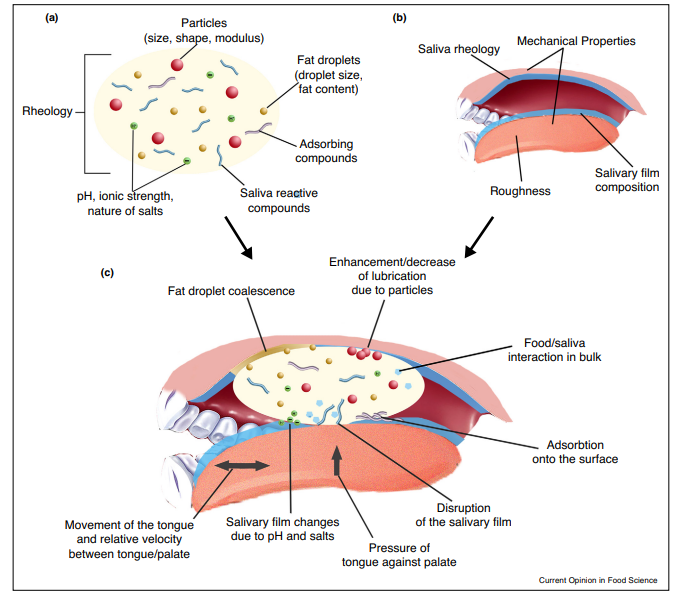I am currently working as a Postgraduate Researcher at the University of Leeds, where I am actively involved in research activities. Prior to this, I successfully completed my master's degree through the renowned Erasmus Mundus joint program, specializing in Tribology and Bachelor's degree in Mechanical Engineering from VTU in Belgaum, India. Further I handle the social media pages for Tribonet and I have my youtube channel Tribo Geek.
Insights into Oral Tribology
Table of Contents
Summary of Article: Oral tribology: bridging the gap between physical measurements and sensory Experience by Clementine Pradal and Jason R Stokes
Introduction
Oral processing involves tribological processes, with a focus on soft-tribology, which studies lubrication, friction, and wear of compliant surfaces in motion. This emerging field, known as soft-tribology, is gaining momentum in research to understand how foods and beverages behave during oral consumption. Researchers aim to identify the fundamental structural, material, and chemical properties in food and beverages that influence the physics at oral interfaces during consumption. This knowledge could enable the development of healthier food products without compromising taste and texture. However, linking tribological measurements with sensory texture perception remains challenging, as the friction coefficient is not an inherent food property but a system property influenced by various factors. While some progress has been made in the last decade, addressing this complexity in food oral processing remains a significant challenge.

Figure-1 Oral tribology as a ‘system property’. Properties of food (a), oral cavity (b) and food/oral cavity interacting systems (c) affecting oral tribology
Lubrication considerations
Lubrication is typically depicted by a Stribeck curve, where friction coefficient is plotted against lubricant speed. Three main lubrication regimes exist: hydrodynamic (at high speeds, determined by fluid mechanics), boundary (at low speeds, influenced by substrate properties and surface films), and mixed (transition between the two). These transitions depend on fluid properties, surface characteristics, and film formation. In oral processing, all three regimes are encountered, with the dominant regime varying based on the food type and processing stage. For example, beverages start in the hydrodynamic regime but shift towards mixed and boundary regimes as liquid decreases. Thicker foods like custards may stay in the hydrodynamic regime longer due to higher viscosity. The challenge is determining the dominant regime at each stage of oral processing for a specific food.
Instruments used
Various instruments are used to measure food lubrication properties during oral processing. The Mini-Traction Machine (MTM) tribometer is widely used, offering versatility in testing a wide range of entrainment speeds (1–3000 mm/s) and decoupling sliding and rolling friction for oral surfaces. This device evaluates lubrication behaviors for different fluids, including food systems and beverages. Another tool, the optical tribometer cell (OTC), provides in situ visualization of contact zones and has been used to study emulsion coalescence and particle distribution in gelatin gels using pig tongue sections. However, its speed range is limited (10–80 mm/s). Newer tribological systems connected to rheometers, such as ball-on-three plate and pin-on-disc geometries, offer wider speed ranges (105–2300 mm/s) but mainly focus on sliding friction. Decoupling instrument effects from lubricant and surface properties is crucial, as the generation of Stribeck curves depends heavily on the measurement system.
Surfaces used
Tribology measurements in the mixed and boundary regimes, as well as transitions between them, depend on the surface properties of the tribological contact. Surface characteristics like roughness, hydrophobicity, and modulus influence both friction and regime boundaries. Using tongue tissue, while resembling the in vivo environment, poses challenges due to biological variability, sample availability, and chemical treatment. To simulate oral surfaces more precisely, elastomers like PDMS are commonly used, but plasma treatment for hydrophilicity has limitations. As research progresses, other biomimetic materials with physiologically relevant properties may emerge. Surface wear during tribological experiments is a significant challenge, requiring strategies to prevent, control, and measure wear to ensure consistent results.
Role of saliva
During oral processing, interactions between food compounds and saliva can lead to three main outcomes: 1) Minimal interaction, where the salivary film’s lubricating properties remain undisturbed; 2) Disruption of the salivary film, causing an increase in the friction coefficient, potentially due to changes in pH, ionic strength, or protein aggregation induced by food compounds; and 3) Synergistic interactions, where certain food compounds can alter the properties of the salivary film, affecting friction, mouthfeel, and texture. These interactions play a crucial role in understanding how different foods are perceived and experienced during consumption.
Conclusion
In summary, while soft-tribology measurements provide insights into the oral behavior of foods and their sensory attributes, correlating friction coefficients with specific texture characteristics remains a complex challenge. It’s crucial to remember that tribology is a system property, not an inherent material property, emphasizing the importance of instrument choice, surface selection, and model foods. Bridging the gap between tribological measurements, in vivo oral processes, and sensory perception requires a better understanding of the entire system. Instruments like the MTM have established theories, but more studies linking friction measurements to sensory data are needed. Tribological fixtures attached to rheometers show promise but lack baseline studies. Future developments should focus on substrates resembling oral surfaces, consider mucosal film, and incorporate saliva for more accurate in vivo mimicry. Thorough characterization of the food or model system is essential for insightful interpretations and advancing our understanding of the relationship between tribology and sensory perception during oral processing.
Reference

Be the first to comment